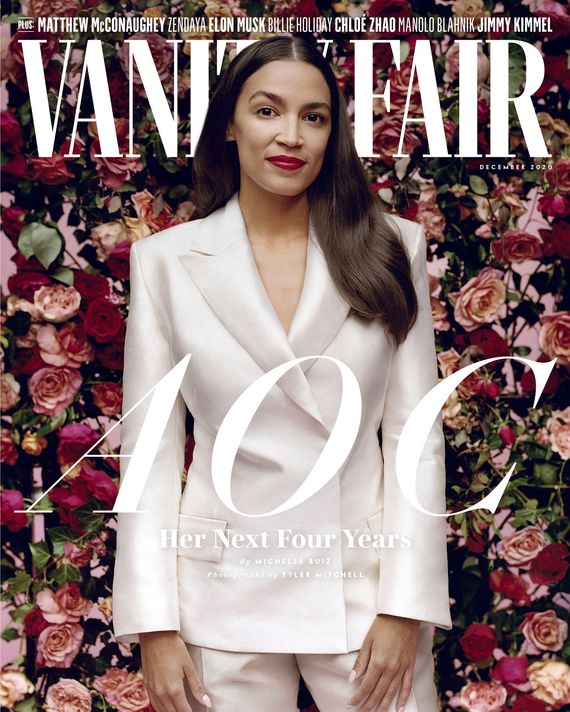
Last week, Alexandria Ocasio-Cortez — she of the Democratic Socialist politics, charisma, and yes, I will say it, dazzling beauty — appeared in a Vanity Fair cover story resplendent in $14,000 worth of fashion and jewelry. On the cover itself, she wore a $1,000 suffragette-inspired white pantsuit by Aliétte and a forthright expression, one eyebrow cocked as if to say, “I dare you to judge me.”
The judgments, of course, came swiftly. “AOC appears in Vanity Fair in outfits worth $14,000 to curse out Trump,” sneer-tweeted Laura Ingraham. “Isn’t she all about being poor and common? Can people in her district wear clothes like that?” asked another Twitter critic (channeling Cinderella’s stepsisters). And even some who support AOC piled on: “I don’t agree with Laura Ingraham, [but] AOC should acknowledge how gross the fashion industry is and why wearing a 14K suit helps the luxury goods market to exist.” (Though $14,000 was the total value of all items worn, somehow the aggregate cost keeps getting attached to that one $1,000 suit, an ‘error’ that conveniently increases AOC’s presumed guilt.)
There is, of course, a grain of truth to some of these concerns. Vanity Fair is a Condé Nast publication, and the company’s long history of exclusivity and rigid hierarchy, often upheld in the name of fashion, is hard to reconcile with AOC’s staunchly leftist principles. (Some might wonder why, just a month after pulling out of the New Yorker festival in support of that magazine’s union, she was willing to appear in another Condé Nast publication that doesn’t have a union at all.)
And, true, a rigorous Maoist might not pose in a pair of Louboutin sling-backs. But AOC is hardly a Maoist, a Communist, or even a “capital S” Socialist. She does not advocate abolishing private industry. She is a government official in a capitalist country, a member of the Democratic party, who leans left. And while she unashamedly avows her own working-class Bronx roots, she has taken no vow of poverty. Since when do we expect elected representatives of economically “poorer” districts to dress according to class preconceptions? Especially in a magazine spread? Is anyone checking the price tags of all the male politicians’ suits?
What then is really behind the rush to subject AOC to these highly punitive purity tests on the subject of fashion? Why do these particular standards get applied to her?
Because she disrupts deeply held beliefs about women. Even prior to this Vanity Fair cover shoot, AOC has long challenged some very basic assumptions about women in the public eye — especially in the way she ‘wears’ her body and appearance. The representative, that is, has an unusually organic and integrated relationship to her physical self — a relationship that she harnesses politically, without compunction. Simply put, AOC is aware that her striking beauty and fashion sense can be just as valuable to her as her political acumen, oratorical gifts, and intense intelligence are. She knows she is attractive; she knows people are looking at her; and she knows the power of this asset. She looks back at the world with a clear-eyed gaze that acknowledges all of this. It is that obvious knowing — that returned gaze — that drives people crazy.
Therein lies her real transgression. The Vanity Fair article merely lends cover to those who wish to reproach AOC for this longstanding, underlying phenomenon.
As all professional women know, there is no sartorial or visual ‘neutral’ for us — no fully unobtrusive uniform that will let us blend completely into the background. No matter what clothes we choose, we are ‘curating’ ourselves, selecting from a seemingly infinite array of options — all of which will be scrutinized for meaning. Skirts or trousers, sexy or serious, long or short, boho or glam — whichever we settle on, we can never enjoy the anonymous simplicity and instant, uncomplicated authority of a man in a suit.
This is because women are the “visible” sex, the half of the species whose visual surface is constantly on display and fragmented into countless smaller sections to be adorned, revered, scrutinized, or reviled. To read any fashion or beauty publication is to confront a long series of recommendations for improving our myriad parts: hair, skin, body, lashes, brows, nails, etc.
Whether we luxuriate in this process of self-presentation or dislike and avoid it, women remain tightly woven into this system. And for female politicians, the single biggest (unspoken) rule of the system is this: You must devote time, money, and effort to creating your public self, yet you must deny any connection to fashion or self-care and feign ignorance of this considerable part of female existence. This is the trickiest part: If you want to be taken seriously, you must pretend the system doesn’t exist. We are expected to disavow entirely the whole process of self-creation (which is abetted by a multibillion-dollar industry).
Sure, we want others to admire or respect our look, but professional life still dictates that women in authority display no interest in or awareness of their own appearance, how it was achieved, or how it affects others. To do otherwise risks seeming vain or superficial.
For beautiful women, especially young ones, this process is harder still. They are expected to glide through the world pretending not to see others seeing them, becoming mere passive recipients of all that looking. To wear the absent middle-distance stare of a fashion model.
AOC refuses to allow that to happen. In a radical move, she has integrated her participation in the fashion and beauty system into her political persona. She had no qualms, for example, divulging her passion for a deep-red Stila lipstick in the color “Beso,” acknowledging that red lipstick — and big gold hoops — are also part of her Bronx Latinidad. She happily starred in a vlog for Vogue.com, demonstrating her elaborate and well-informed skincare and makeup routine (she can contour!), and taking visible pleasure in studying her own lovely, dimpled face. It was fun to watch.
What’s more, AOC seamlessly integrates that part of herself into her congressional self. The AOC of the beauty vlog is recognizably the same AOC who in July stood up in the House of Representatives to deliver a drop-dead brilliant speech rebuking Representative Ted Yoho, Republican of Florida, for publicly insulting her on the Capitol steps. In that soaring, impassioned address about misogyny and feminism, AOC famously took apart Yoho’s shabby attempt at self-defense — his invocation of his wife and children as testaments to his good character: “Having a daughter does not make a man decent. Having a wife does not make a decent man.”
She even mustered the aplomb to repeat the ugly epithet Yoho had hurled at her — “fucking bitch” — ensuring his sexist profanity got memorialized in the Congressional Record. It was yet another way for Ocasio-Cortez to gaze back, to hold a mirror up to those who would objectify and demean her. The day of that speech, AOC had armed herself with a red power blazer and her trademark red lipstick. She knew her bright makeup and outfit were the sartorial equivalents of her high-octane oratorical performance.
The brouhaha over Vanity Fair was hardly the first time Ocasio-Cortez has incited weird censoriousness. Last year, a different puritan lynch mob found fault with an old video they’d unearthed of her during her college days, committing the sin of … dancing.
“After Alexandria Ocasio-Cortez is forced out of office after one term she can go dance on a stage that has a pole,” wrote one typically vicious critic.
AOC responded by filming a video of herself dancing once again … right into her new House office, with the caption “Congresswomen can dance too.”
Here again, AOC brilliantly integrated the myriad parts of one woman’s life, openly embracing the very thing her critics tried to portray as “secret evidence” of her unserious or vulgar past. Dancing, like wearing couture in Vanity Fair, is a bodily performance, an acknowledgment of pleasure in the physical self, in sensuality (hence the insulting “pole dancer” remark). Those who berated Ocasio-Cortez for dancing joyfully at age 20 are little different from those who berate her for wearing couture in a magazine at age 31. They are all condemning AOC’s obvious pleasure in her self — the easy way she inhabits her physicality, and, yes, her sexuality.
That knowing ease is threatening to those who would prefer women — particularly women of color, particularly gorgeous ones — to remain passive objects to contemplate, bodies without minds (and who would prefer that women like AOC never return the gaze, that she disavow the whole system).
Instead, Ocasio-Cortez does the opposite, becoming the first high-profile political woman fully to acknowledge, and use what you might call the ‘theater of feminine self-creation.’
No one can “catch her out” or “expose” her interest in dancing, make-up, or fashion, or shame her for embracing the accessories of her Latinx girlhood in the Bronx, or her sexuality — because she owns it all. AOC is not embarrassed nor does she try to hide her ‘backstage’ self. She has integrated it fully into her ‘onstage,’ congresswoman self. And that integrated self is on full display in Vanity Fair.
In this way, Ocasio-Cortez feels like a “category error” to some people: She may look like one of the women who mutely advertise commodities — and seem to morph into commodities themselves — but she isn’t one. Surprise! she seems to say, those women were real all along — not merchandise to ogle. And when a woman in power looks back at us with wit and self-aware pleasure, she blasts apart any implicit connection between women and things. This unsettles and disorients her critics, who respond with anger and accusations.
And what do they accuse her of? Superficiality and hypocrisy — of not being what she claims to be. In fact, though, AOC exposes the superficiality and hypocrisy of antiquated gender norms — the old rules that require women to choose between seriousness and pleasure, Congress and couture. She exposes the outdated folly of asking women to maintain a firewall between feminism and women’s popular culture (including fashion, beauty, and glossy mags).
AOC is tearing down that firewall, and in doing so she helps usher in a new politics — a politics that liberates women from fashion-shaming, and offers the option of making new, powerful use of an old arsenal — the everyday rituals and delights of self-creation.


